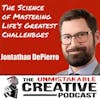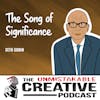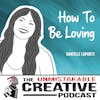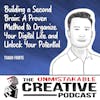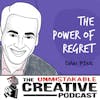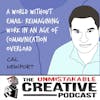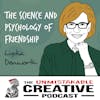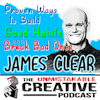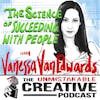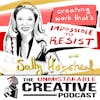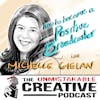Jonathan Depierro
#UC-Transcript
Srini Rao:
, Jonathan, welcome to the unmistakable creative. Thanks so much for taking the time to join us.
Jonathan DePierro:
Sounds good.
Jonathan DePierro:
Thanks for having me on.
Srini Rao:
Yeah, it is my pleasure to have you here. So I found out about you by way of your publicity team who told me that you wrote a book about resilience, the science of mastering life's greatest challenges. And I thought, okay, if somebody took a scientific lens to resilience, I definitely want to talk to them. But before we get into the book, I wanted to start by asking, what did your parents do for work? And how did that end up shaping what you have ended up doing with your life?
Jonathan DePierro:
Yeah, so very good question. My dad works as a bond trader. So I learned, I think, late in him having that job that a bond is a little bit of corporate debt and he exchanges that among companies. And so he works for a bank doing that. My mom is a stay at home mom. I have six younger siblings. So that's quite a lot of work that that takes to coordinate.
you know, all the things that they need to do. And my sister is about 24 years younger than me. So there's a huge range of different ages. And I would say that I was inspired more so by what my grandparents do. So my grandfather on my father's side was the CEO of a small hospital on Staten Island for a couple of decades, St. Vincent's Hospital on Staten Island. And my
My maternal grandfather was a telephone repairman. So I learned a couple of different things. I learned altruism from my paternal grandfather, and I learned the importance of thinking creatively, solving problems, working with my hands, thinking in three dimensions, and got a lot of encouragement from my maternal grandfather. So I think all of that together.
set me up to be working in healthcare, becoming a psychologist. I sort of grew up in hospitals. I should also add my maternal grandmother was a x -ray transcriptionist. So in the olden days, a doctor would call in and read out what an x -ray report is and she would be the one typing it up. So I spent a lot of time hanging around hospitals. So it really set me up, I think, well for my career.
Srini Rao:
Well, you mentioned six siblings. Like I always feel like people who grow up in huge families have this like inherent knowledge of social dynamics and human behavior that the rest of us don't get. Being the oldest, like a couple of things I wonder if you're the oldest. One, I'm guessing your siblings would agree with me, given that, or you would agree with me, given that you're older, that your siblings probably got away with murder compared to you. At least I feel like my sister did compared to me. And so a couple of things I wonder, one is what you learned about, you know,
like human behavior and how did the advice that your parents passed on about making your way in the world change from sibling to sibling, especially with so many of them in such a huge age gap?
Jonathan DePierro:
Yeah, so I can give one example. When I was born, my parents were young parents. They were in their late teens when they had me. And so I spent a lot of time raised by them, but also my grandparents. And in both of my respective grandparents' homes, they put all of these plastic outlet covers for safety and the electrical outlets when I was just born, before I could even move around. And...
they stayed there for like 30 years. And they, I think, were extra cautious with me and put all these safety precautions in place, I think more so than were actually necessary. And it might have prevented me from exploring and taking risks and, you know, falling and bumping my head and learning not to do that thing. But I think over time, they learned that they don't need to be so careful and protective.
Srini Rao:
Yeah.
Srini Rao:
Mm hmm. Yeah. Well, I had a boss who once told me that's pretty much how all parents are with the first kid. They're like that they're going to constantly kill themselves. And then the second one. Yeah, I have a nephew who if he watches you baby proof something, he'll undo it. We have to like literally make sure he's not watching when we do it. And now that I've experienced this with a 17 month old kid, I realize now I'm like, wow, like on the one hand,
Jonathan DePierro:
Mm -hmm.
Jonathan DePierro:
They baby proof everything.
Jonathan DePierro:
Hahaha!
Srini Rao:
we have to basically give him the freedom to explore. And the same time we're balancing this with like our constant fear that he's going to hurt himself. And I'm pretty sure he's his worldview is, I want you here by my side, I want you to pay attention, but I also want you to stay the hell out of my way. Like the
Jonathan DePierro:
Yeah, I was also thinking about my sister who at one year old knew how to work an iPad.
Srini Rao:
Yeah, yeah, I mean, it's mind boggling to to watch. It's funny because I think that really ties well to this idea of resilience. But so what led you down this path to studying all of all things resilience? Because there's so many ways areas we could go when you think about sort of mental health and psychology.
Jonathan DePierro:
Yeah, so I think one of the past was that I did a PhD in clinical psychology at the New School for Social Research, which is in lower Manhattan. And during my training, I was lucky to be in a lab with a mentor who was studying psychological trauma and looking at brain imaging, looking at physiological responses to psychological trauma, really showing that it has a real impact on the brain and the body. It's not just all in your head. And,
She had a lot of research grant funding to do this. Her name is Dr. Wendy DeAndrea. I was really lucky to have her as a mentor. And so I learned the biology of the impact of trauma from her and that really informed my work and understanding. I learned a lot about resilience from folks who had been through lots of difficult experiences, some of whom developed PTSD or depression or anxiety, some of whom didn't. I learned a lot about resilience from my patients. So very early on in my training,
I worked at Mount Sinai's World Trade Center Health Program as a trainee. Even before I had my PhD, I was learning to be a clinician and working in this program. And Mount Sinai has a 22 or 23 year history now taking care of the physical and mental health needs of World Trade Center first responders. And I really had the pleasure of taking care of a lot of those folks, mostly men, mostly retired law enforcement.
who were struggling with PTSD and depression from the horrors of things that they saw down at ground zero on the day of 9 -11, but in the six months plus of recovery and effort afterwards where they were recovering body parts and lots of human suffering that they witnessed. I mean, I saw resilience in their stories, right? Even that they came to see me for therapy and overcame any stigma that they might have or internal prohibitions.
is resilient, that they were reaching out for support and using the resources of therapy. That's pretty resilient. So I learned a lot from, I think the most I've learned from my resilience has come from patients who are struggling with mental health conditions.
Srini Rao:
You know, so, you know, as I was going through your book, I think, like I said, one of the reasons I wanted to talk to you was that you were somebody who had actually studied this in a laboratory setting and are like had real science to back this up because I'm curious, like from the perspective of somebody like you, when you see these sort of inspiring self help books with, you know, like sort of platitudes that are sound good, in theory, but don't necessarily work in practice, like, what do you make of that from your perspective?
And why do we have this sort of pseudoscience of things like resilience and mental health?
Jonathan DePierro:
Yeah, resilience is one of those tricky terms. It can mean a lot of things to a lot of people. For some people, it could mean just think positive, just be tough, just have a stiff upper lip, just think about the bright side. And that is not how we think about it as serious scientists. And that's right. I think there are a lot of self -help books out there, some of which take one scientific finding and make an entire book and philosophy out of it. And what we know about scientific findings is that
Srini Rao:
Yeah.
Jonathan DePierro:
Often they don't replicate, often they don't, they're not reliably found if you do another study and another study and another study to try to find the same thing. So I think there's a cool finding that people sort of run with sometimes and people find enticing. But the difference with our book is that it's a conglomeration of many, many, many different studies, some from us at Mount Sinai, but many from researchers.
on the outside and it ties together with personal stories. So it's not just one thing amplified, it's many, many different things that tell a coherent story about what goes on in the body and what people can do to adapt, recover and grow from life's challenges.
Srini Rao:
Yeah, we'll get into all that. So how do you like, what is the design of the science of studying resilience? Because it's not like you can be like, Hey, we need some volunteers for hell. Yeah. It's like, we're going to put you through like misery and see how you do. I mean, you know, like this isn't the Philip Zimbardo era. Like, so how do you actually study this? Like, do you just find people who've been through trauma and you know, like how do you
Jonathan DePierro:
Mm -hmm.
Srini Rao:
How do you maintain objectivity in all of this? Like, how do we prevent biases from coming into this? Because I feel like this is just like ripe with room for misinterpretation due to bias.
Jonathan DePierro:
Yeah, I mean, I think that's that's part of where there are many protections in the scientific literature, for example, in the peer review process, people looking over what you've written up and how you've interpreted the data. And there's also open what's called open science practices where people even say ahead of time, this is my hypothesis, this is how I'm going to study it. And oh, by the way, after I do the study, here's my data so you can look to make sure I interpreted it correctly. So there are all of those controls in place to try to address some of that bias in.
psychiatry and psychology, but I'll say that there's a lot of different ways to study resilience. And you're right. It's not that we can say, here's this group of people, we're going to put them through hell and then study how they deal with it because that's not ethical. And no one would sign up for that. But there have been, unfortunately, a number of examples that have been really informative in advancing our study of resilience that have come from disasters,
natural disasters, man -made disasters, the pandemic, the World Trade Center response, army and other armed service members going off to combat and being studied before and during and after. So there are what we might call natural experiments in resilience. And many scientists, including ourselves, have really looked to these people to learn a lot about resilience. So people who have been through
some of the worst things that you can imagine. We mostly get them afterwards and say, what's helping you now, Co? Looking back on the last few months, has it been social support, optimism? What's been helping you manage these things? I have colleagues that have followed World Trade Center responders for 20 years and can say a lot and have written a lot about what's fueling their resilience and recovery.
I have a colleague who has really pioneered studying resilience in service members, in veterans, hundreds of studies that have been done on that. And there are also, I should say, smaller examples. So we can bring people into the laboratory and do stressful things with them. So for example, one analog for resilience, and I'll give you a couple of examples, but one analog is something called the Trier Social Stress Test.
Jonathan DePierro:
I'm not sure if you've heard of this before. It's a pretty frustrating thing to do. So you bring somebody into the laboratory and you say, uh, we want you to defend yourself, make up a script, defending yourself against a false shoplifting accusation. You've been accused of shoplifting. You have to defend yourself to a judge and we have a research coordinator come in. They are stone -faced. They look really stern. And the participant has to give this speech defending themselves against this accusation.
So they do that. And then, because that's not enough, they have to do mental arithmetic. So subtract three or 10 or 12 from 100 continually until we tell them to stop. And if they make a mistake, they have to start over. So I did this in graduate school. This has done a number of labs across the country and internationally. This is an analog. First, this is a stress induction.
And we can measure, we can really see spikes in cortisol and other stress responses even during this 30 minute analog situation.
Srini Rao:
Yeah.
Srini Rao:
Well, let's talk about how we define resilience because one of the things you say early on in the book is that you cannot say a person is resilient unless they have had challenges thrown in their way. They must be resilient, resilient to from or following some stressful or traumatic event. Uh, you know, and I think that you offer a pretty extensive definition. So can you kind of define it for us? And we'll kind of talk through sort of stages of life, you know, body reactions and all those things.
Jonathan DePierro:
Sure. So the way we understand resilience is really summarized as the ability to adapt, recover, and grow from life's challenges. That requires life challenges. And you could say people might have character strengths and so on, but it's important to understand how those strengths help you when you actually encounter adversity. So sometimes I think in a tongue -in -cheek way, when I do presentations about resilience, I show a picture of
Srini Rao:
Mm -hmm.
Jonathan DePierro:
somebody meditating on a mountainside in perfect serenity, and I say, this is not what I'm talking about. Because there's the best case scenarios, that someone who might not have been through, in many cases people are saying, oh yeah, I'm resilient, I'm strong. Well, they might not have been through something to see how those resources that they have both internally and externally in their community can be mustered to help them recover.
Srini Rao:
Yeah.
Srini Rao:
Hmm.
Srini Rao:
Yeah. Well, you know, I wonder a couple of things. One, what is the role of environment when when I say environment, I mean, parents, genetics, all of these things in a person's resilience. And of course, like, you know, sometimes I like I probably had one guest in probably 1300 who told me that they didn't have any sort of like all his last moment in their life. And I thought I was like, you're lying. That or you just want to sound good.
Jonathan DePierro:
Mm -hmm.
Srini Rao:
But the thing is, I wonder why certain people react to stressful situations the way they do. Because, silly example, one person could have a breakup, another could have a parent, and the person who has a breakup could have a far more dramatic response to the situation.
Jonathan DePierro:
Mm -hmm.
Jonathan DePierro:
Yeah, so you mentioned genetics, you mentioned parenting, and even community, the community you live in, the resources available to you, neighbors, the availability of psychotherapy, the availability of medical resources, the financial stability of your neighborhood in general. All of those things contribute. And just like everything in life, part of this is genetically determined, but much of it is teachable. Even if you've got a...
lower than you'd like genetic loading for resilience as a trait, it's something that, it's not that all is lost, it's something that you can learn and embrace. And I think you got back to something really important, which is that there is what we call heterogeneity in response to stress. Again, part of it is your natural stress reactivity, like how much stress does it take to completely knock you off equilibrium? And then how quickly do you recover? There's a lot of...
variability within people and how intense the stress response is, even to a minor thing, and how long it takes them to recuperate and get back to baseline. And what they tell themselves at the time really matters. So one of the examples I give in the book is you can imagine a kid studying for a math test, getting a bad grade, and then saying, I can't do this, I'm just going to give up. I might as well never like,
pick up a career that requires math, and then they sort of fail, or they withdraw for the rest of the semester, they don't study, they fail the course. Or another kid who says, all right, well, it's one grade, it doesn't determine where I'm gonna be for the rest of my life, it doesn't determine anything about the rest of the semester, let me see what resources are available to me. What they tell themselves at the time of the adversity really matters. The story they tell themselves and the cognitive flexibility that they have really matters.
because it can determine what you feel and what you do. This is basic cognitive therapy.
Srini Rao:
Mm hmm. Let me give you a really stupid but simple example of something. So my mom is kind of one of these people who needs the house to look like Buckingham Palace. And if you're holding something in your hand, and it looks like you're going to drop it, like she literally will just start like freaking out and say, don't drop it, don't drop it. And I remember I was living with my two roommates, and I dropped the bottle of ketchup. And I was like, fuck really loud. And my friend's like, what happened? I'm like, I dropped some ketchup. He was like, dude, what the hell? And I realized I was like,
Jonathan DePierro:
Mm -hmm. Mm -hmm.
Srini Rao:
Wow, that is my mom's conditioning at work. Like, tell me what that's all about. Like that is just, I mean, you can think about it, right? Like I don't live in my parents' house anymore yet in my own house where literally I can just pick the stupid thing up and wipe it up. I had almost the identical response to dropping.
Jonathan DePierro:
Yeah, that's how learning and memory work. I immediately thought of the saying, I can't remember who it was attributed to, but that it's okay to drop balls. You just need to know which ones are rubber and which ones are glass.
Srini Rao:
Yeah.
Jonathan DePierro:
But yeah, I mean, it shows that early conditioning can be important, but these things are unlearnable. You can realize, okay, well, I dropped a bottle of ketchup that I paid for in my own house on my kitchen floor and nothing horrible has happened.
Srini Rao:
Yeah, no, trust me, like I don't have that same reaction anymore. It took me that experience to recognize that. Well, speaking of parenting, you may have read it. Jonathan Haidt has a new book coming out called, I think if I remember correctly, it's called The Anxious Generation. And he wrote this lengthy article on the Atlantic about bringing back what he called a phone -free childhood. And a lot of what's in it is incredibly disturbing. And in a lot of ways, you could conclude from that article that...
Jonathan DePierro:
Thank you.
Srini Rao:
we're creating a generation of kids who are not resilient in any way. So I wonder when you think about it from the standpoint of the world that young kids, particularly those of, you know, who have like parents who have teenagers that are growing up in like, what would you tell them about everything that you have learned from your research?
Jonathan DePierro:
Yeah, I tend not to think categorically. So I would shy away from saying we're building a generation of not resilient kids or every kid is anxious. I think we've seen an uptick in percentages and rates of kids experiencing anxiety. There's some research, although there's some mixed evidence to say that social media engagement or time on the phone is contributing to that anxiety.
Srini Rao:
Yeah.
Jonathan DePierro:
I know I spend a lot of time on my phone and I have some like cognitive flexibility to be able to filter some of that content. And it's relevant to me that other, that kids might not. And there's been, you know, obviously writing about things like cyber bullying that happened in social media platforms, on TikTok. Someone could make a video making fun of, you know, a classmate and they could go viral. And that has a real impact because it's permanently out there in the world. Or it can feel like,
to the kid who was the target of that that is permanently out there in the world. And things that might have been kept private before on a paper note you pass in class can now become quite a sensation, unfortunately, online.
Srini Rao:
Yeah. Well, so talk to me about how we begin to build this skill of resilience, because you offer several different frameworks, you make this distinction between optimists and pessimists. Like, let's begin with sort of like, you know, obviously, there's this body response, like, what the hell is going on in the brain, when we have a stressful situation, but then also what is happening from a neurological standpoint, when we demonstrate resilience.
Jonathan DePierro:
Yeah, so I also hate to be reductionistic about the neurobiology, but in general, what happens when we're resilient is that our prefrontal cortex, which is the part of the brain that sits above our eyes and is the most, as you might say, highly evolved, says, stop, wait, slow down. Let's dial back this response. Am I actually under threat or not? It gives inhibitory signals.
the slow down, stop, evaluate, let's think about this a different way, inputs to the emotional, what are typically historically considered to be the emotional areas of the brain like the amygdala. Now that's a gross overgeneral oversimplification. But in general, people who are resilient exert more prefrontal inhibition in times of stress. They
They think more flexibly. They can modulate their responses adaptively. They can evaluate the situation from a 50 ,000 foot view and see different ways out of it. They lean on supports or they at least think to lean on supports for someone who is in the throes of panic for a long period of time, can't even think about the resources available to them. So that's kind of what happens in the brain of somebody who's resilient in the body we see.
Certainly there are stress hormones that circulate in people who are resilient, even those who are resilient to have stress hormone activation, but it gets back to baseline faster in those people compared to people who are persistently in a state of distress or stress. One thing I'll say about this is that,
It's important to take a step back because, like, for example, for phobias, people have a horrifically strong fear response, and somewhat understandably so, but they have a strong fear response to situations that are not actually life -threatening. So one of the most common fears is public speaking.
Jonathan DePierro:
and they imagine all sorts of embarrassing situations and their body is having a response as if someone is pointing a gun at them or if they've just gotten in a car crash. Their heart rate's elevated, their digestion's stopped, they've become sweaty, their mind is racing, they're overwhelmed and they're having a response on par with an actual life threat. And part of the recovery from that and part of addressing that is reminding themselves.
Actually, I'm safe. I'm not under physical threat right now. I've made a bunch of made up a bunch of scenarios in my mind about worst case scenarios, and it's causing me to avoid. I need to be facing my fears and engaging with it to realize and recognize that I'm actually safe.
Srini Rao:
Well, you mean the sense I'm getting from talking to you is that like we can say resilience is basically something people have on a spectrum. Just reading your book. So talk to me about sort of where people fall in that spectrum, how they end up there and more importantly, like how they can be on the more resilient. And if we were to say, put this on a spectrum of the least to the most resilient, like how do people move up that spectrum? Like what kind of skills?
Jonathan DePierro:
Mm -hmm.
Srini Rao:
do they need in order to do that? Cause I know you offer like a lot of the common things like mindfulness and we'll get into some of those. But if we look at it just from a really basic, we'll just, you know, we use an example, let's use two examples. One of like a, you know, mildly stressful situation. Like somebody sends me an email, like, you know, basically screaming at me via email. And then, you know, I'd like to hear it through the lens of, you know, some of the people that you've worked with who've been through, you know, far more traumatic events.
Jonathan DePierro:
Right. And I think the way I think about resilience is more so about having a wide array of tools that you can lean on. Some people find one particular tool to be helpful and it's their go -to all the time, but it can often be very helpful to have an array of different resources at your disposal to kick and choose from, you know, what is most helpful to me, or maybe I'm going to go to this tool first and I'm going to do this thing and then I'm going to do this thing. So maybe I can turn it around and first ask you,
when you get an email of somebody yelling at you, what do you do such that it doesn't stick with you the entire day?
Srini Rao:
Well, this happened to me recently, which is why he used that example. It didn't stick with me the entire day. It stuck with me for an entire week. It put me kind of in a funk. You know, even of course, I realized the consequences were not anywhere as near. They weren't dire. I think it was like it was more than anything. I felt bad for a really long time, like way longer than it put me into a funk. Let's just put it.
Jonathan DePierro:
Yeah, and I guess maybe what I'm asking is when that person sent you an email yelling at you, did you have a judgment about yourself or about them that helped those feelings to stick around for so long?
Srini Rao:
Yeah, kind of. I mean, I think that like, I had put all this work into something and somebody wasn't very happy about it. And I thought, you know, like, wow, in my mind, I just started going through like worst case scenarios of like, maybe this the whole thing is just all over. And I, you know, my career, it was like, I kind of just played out like the worst case scenario in my mind. Does that help?
Jonathan DePierro:
Yes, because I think what I want to point out is that this is an example of going back to that cognitive model. What you tell yourself at the time of distress really matters. And if something relatively minor happens objectively and you say to yourself, oh, this whole enterprise is all over, I might as well pick a different career, that it's called overgeneralization. And that certainly doesn't help. And I think people who build up the muscle,
muscles around resilience, the cognitive muscles, are able to put those negative thoughts under the microscope. We all have them. I have them all the time. But I have to do this myself. I have to put it under the microscope and say, is this thought helpful? Is it realistic? And if not, I have to challenge it and think about what is actually more helpful and more realistic for me to be thinking. And I often liken it to having a very aggressive prosecutor voice.
and a sleepy, ineffective defense counsel. And it's not necessarily about just seeing things as rosy, because there are challenges in life, but it's about seeing the world realistically and helpfully. What is going to be most helpful to get me to my goal? What's most helpful for me to be thinking? Is it most helpful for me to be thinking that this one email is the death omen for my career or for my project, or that
Srini Rao:
Mm -hmm.
Jonathan DePierro:
this person is unhappy and maybe I can do something in the short term to fix the situation, but it doesn't necessarily predict anything about where this project's going.
Srini Rao:
Yeah, absolutely.
Jonathan DePierro:
So I think, yeah, that's an important small -scale example, but the same is true on a bigger scale. So for example, after traumas like, I'll give you an example from 9 -11. So a number of first responders, and maybe some are listening, a number of first responders to 9 -11 were plagued afterwards by thoughts that they should have saved more people.
or that they should have been the ones to die in the building and not their colleagues, or they were kicking themselves because they could have done more that day. Now, that's understandable given their role as first responders, as police and firemen, and save people and protect the public, but that's not a particularly helpful thought in terms of the level of stress they might be feeling and the level of distress that that thought might feed into. And I think in therapy,
And then through talking to colleagues, they can learn to challenge that. And for example, think, you know, I did the best I could in a ridiculously chaotic situation. Not, I could have done more and maybe more people like wouldn't have died if it wasn't, you know, if I did more. That's not helpful. And we don't have a crystal ball to go backwards.
Srini Rao:
Yeah. Well, you know, I think that of all the things that I always wonder about, and I always say that there's no self -help book for this one. And I've talked to people who have lost parents and that experience is the one thing I'm always like, God, how am I ever going to get through that? Even though it's like a natural part of, you know, like that's just part of being human is that we lose people. And I've always wondered about this. I'm like, how in the hell do people get through that?
Jonathan DePierro:
Yeah, my wife is also a clinical psychologist, which makes us a hit at parties to clinical psychologists who specialize in traumatic stress and global disasters. So great conversation topics that we bring up. But one of the things that she tells folks, one of the analogies that she finds helpful, also I think attributable to others, is that grief is like a tree that gets struck by lightning.
Srini Rao:
Yeah, I bet.
Jonathan DePierro:
where there's evidence, if you look at the tree rings, of the scar, of the impact. And yet, if the tree survives, there's rings of life that are added on top of it. So it's not about moving on. It's not about forgetting or leaving it in the past. It is going to have an impact. You have to acknowledge that this is something that is awful. It may be part of life, right? That life isn't permanent, but it is tragic.
It can leave an impact. You'll always be upset thinking about it. So I think it's unrealistic to think that you'll be looking back on a loss and not feel upset. But the goal in that model is to add life on top of it, not to move on, to keep the memory in mind, but continue to engage in life afterwards. Continue to be a member of your community, continue to be a member of your family, honor their memory in some way.
I recently met the parents of someone who died by suicide, and really tragically died by suicide. And they very quickly, in the midst of their grief, started a foundation in their son's honor, such that people who had his job would be less likely, would have resources available to make it less likely that they may die by suicide. And we saw that actually, even during the pandemic,
You might know Dr. Lorna Breen was the chief of the emergency department at Columbia University Medical Center and she died by suicide early on in the pandemic and her family started the Lorna Breen Foundation and then really set off a lot of advocacy at the national level to honor her memory and to make it easier for healthcare workers to seek help.
Srini Rao:
Yeah. One thing you say in the book is that each time we recall a positive memory and stay with the emotions that come up in us, we make a new memory trace in our brain and build a mental habit of positive thinking, intentionally increasing your positive emotions activates part of the brain associated with pleasure. I didn't know that. Like I, like that seems so simple to me because it's not like we all don't have joyful memories in our lives. Like I never thought. So explain to me how that works in practice.
Jonathan DePierro:
Yeah, I'll give you an example actually from work of a colleague of ours, Daniela Schiller. Dr. Schiller has a laboratory at Mount Sinai. And I'll just focus in on one experiment they did recently where they had people come in from the community into the laboratory and there were four, three or four groups of people. They did three or four different things. One group of people thought about a traumatic event that they've been through and
the meaning that this had for them and some of the things that they've grown out of or some ways in which they've grown as a result of the experience. So that was one group. They talked about the memory and how they've grown afterwards. Another group of people talked about the memory and it's just its negative impact. That's group two. Group three talked about the memory, but just the facts of the situation. I was driving down the street and I got into a car accident at this time. These are the number of people involved, like a police report.
And another group of people played a cognitive game that had nothing to do with the memory. One of the things that they found is that the group that was asked to think about the growth that occurred after the event and its personal meaning felt more positive afterwards. And when they came back into the lab days later, when they thought of the memory again, they felt slightly more positive and less negative. So the teaching here...
is that any time you a memory is not set in stone. I used to think and I think people are brought up to think that a memory when you have it is set in stone like you're carving it in and it's always going to be the same when you remember it decades later. That's just not how it works. Any time you bring up a memory, you have an opportunity to put it back in your brain differently. This is how therapy works. But this is also how you know, the stories told at family dinners work. You tell a story.
people elaborate on it, and the next time you tell it, you add the elaborations and the flourishes. So it changes every time you bring it up. And same true for traumatic memories. Every time you bring it up, you have an opportunity to, it's called reconsolidation, reconsolidate the memory a different way. You put it back with a slightly different story, put it back with a slightly different spin on it. And that affects...
Jonathan DePierro:
how upset you are the next time you remember it. The emotion and the facts are stored together. So if you change one, you change the other.
Srini Rao:
Mm -hmm.
Srini Rao:
Yeah.
Srini Rao:
Wow.
Jonathan DePierro:
So memory is really malleable. And I think that's something that people, especially when they say, like, I've been through this situation and it's going to scar me for life and I'm always going to be affected by it. And it's going to permanently change the way I see the world. That just doesn't line up with how the brain works and the growth potential of the brain and our memory systems.
Srini Rao:
Yeah. Well, let's talk about fear. I think what struck me most that you said about fear, you said the military believes that knowledge is power to master fear successfully first learn as much as possible about what's feared. When I, you know, when I was thinking about this from the standpoint of resilience, like I, I, you know, I'd been a surfer for 10 years and I remember thinking, I was like, well, one of my friends is, you know, it's like, how do you like, you know, survive the impact zone? I was like, you basically take a lot of waves on the head and then you realize more waves you take on the head, the more.
tolerant you become to getting your ass handed to you in the water.
Jonathan DePierro:
That's right. And I think that's something we learned from the special forces. Some of the very high level folks that we interviewed who have been in the special forces talk about gut check experiences, even the seal buds training. It is grueling mentally and physically, and you build up your tolerance for physical discomfort and you face failure and you pick yourself up off the sand and you carry on and or your buddies help pick you up and you carry on together.
Setbacks are part of life and the more you can face those and You know get back up again the better prepared you are for the challenges that you you go on to in the future one little setback doesn't mean that you're going to foul at the big thing and in fact it can set you up for Facing it even more adaptively right the military trains Extensively for operations. They practice every little bit so that when the the
mission happens, they know how to do the mission on paper and if there's a slight modification, they can do it and adapt to it. And if things go completely sideways, they have a backup plan and a backup plan. Having all of that written down and practiced beforehand is exceptionally helpful in managing what is certainly going to be a uncomfortable, at least sometimes like threatening, sometimes very
um, dire situation that they might face.
Srini Rao:
Yeah. Well, so, you know, this is another one of those things that a morbid curiosity and something I think a lot about when it comes to fear in particular is like finding that line between risk and recklessness. And I always wonder to my nephew, I'm just thinking, I was like, dude, you need to figure that out where that line is right now. Like you don't know where it is, but you're 17 months old. He's cautious, but like, I've always wondered about that, you know, when it comes to fear in particular, because that line is like almost in a lot of cases, it's very thin.
Jonathan DePierro:
Yeah, and I would say that I would like look to others to set that boundary. And sometimes people can be frankly reckless, but you can also look at a progression. You don't. So for example, if you're surfing or even skateboarding, you're not going to do those massive loops flip up in the air, 360, you know, 20 feet in the air and land again, right out of the gate. You want to start small. You want to just like balance yourself on the board first before you go to like you're sitting at the edge of something.
know, if you're skydiving or, you when people in the military, for example, practice jumping out airplanes, they jump from like two feet first, just to practice landing on their feet. And then they get higher and higher, they have a tether attached to them. They might jump tethered to somebody out of an airplane, just to get the experience of jumping out. And then they're going to jump out during daytime. And then way down the road, are they jumping out in the middle of the middle of the night in a snowstorm into enemy territory. So start.
Srini Rao:
Yeah.
Jonathan DePierro:
exceptionally almost like annoyingly small before you when you're trying something new.
Srini Rao:
Yeah, I mean, I think about that from the standpoint of surfing, like I'd gotten to a point where it was like bigger and bigger waves until I thought I was going to die in Nicaragua. I was like, guess what? I think I've hit my limit. Like it was like a 13 foot day. And I was like, I don't need to experience that ever again.
Jonathan DePierro:
Um, so I would say that having a role model is really helpful here. Having a role model to, to let you know, Hey, like maybe not try this thing because it's, it's a little bit too dangerous. I kind of feel this way when I watch, I love watching those documentaries about free climbing, like free solo, but then I realized I'm never going to do that. And the reality is that a lot of those folks die early.
Srini Rao:
Mm -hmm. Yeah.
Srini Rao:
Yeah, absolutely.
Jonathan DePierro:
It's liberating for them. It's a huge personal accomplishment. It's a huge athletic achievement and just watching them balance on two fingers. But I know that I'm never going to do that and that it's maybe a little bit too dangerous.
Srini Rao:
Yeah, well, we don't want to caught my attention. And this is because I'm somebody who thinks that all Indian religious services take too long. If you've been to an Indian wedding, which you work in the medical field, so I'm sure you probably know some Indians, but you say regular attendance at religious services may foster resilience factors, including social support, optimism, altruism, and search for meaning and purpose. Can you say more about that? Like, why?
Jonathan DePierro:
Right, so I think that meaning and purpose especially is exceptionally important and maybe under understood or under appreciated. One of the ways that we see this is this idea of post -traumatic growth. I think post -traumatic growth, just like resilience can get a bad rap for being too positive. Okay, you go through something terrible, just look at the bright side, look at all the positive ways you've changed afterwards. And that can really...
diminish the impact or it can feel like it's not acknowledging the real emotional impact of the event. What we know is actually when we studied our own healthcare workers who responded to the first waves of COVID, it was awful here. 80 % said that they changed in at least one positive way as a result of their work on the pandemic. So I'd encourage your listeners to think about events that they've had in their lives. Think about whether they formed new personal connections as a result of it.
whether they have a better appreciation of their own personal strengths and abilities, whether they have a sense of new meaning and purpose in their life or a new spiritual connection. A lot of our healthcare workers said that they did, and you might not expect that. You saw horrible things on TV. They experienced horrible things, but they reported a lot of growth. What we also know in parallel to that is that our healthcare workers who told us they were experiencing a lot of symptoms of PTSD,
actually reported the most growth. And that's something that's, I think, a newer recognition that the stress and suffering that come along with conditions like PTSD or depression or anxiety can almost fuel the growth or force you to take a look at your life and say, okay, like, who am I now that this has happened to me and it's had an impact? And so I think that's an important recognition. Growth is not positive. I mean, I remember really vividly,
like my bones growing when I was a teenager, like preteen, and it was incredibly painful. I remember my wrists and my feet hurting in a way that just wouldn't go away. It was really bothersome. And that was my joints growing into new positions. And I would say that I think that the problem here would be to say that growth after a trauma is just positive. It is distress.
Jonathan DePierro:
and growth at the same time. It is distress and opportunity at the same time. They go together and the distress might even fuel the growth.
Srini Rao:
Yeah. Well, you know, let's talk about social support in general, because I think that, you we like to that we were at a point where Vic Murthy even wrote a book about what we have now is a loneliness epidemic. And I didn't realize it, but the UK apparently has a minister of loneliness whose job it is to ensure that people aren't lonely.
Jonathan DePierro:
Yeah, so loneliness has a huge negative impact. We actually see this loneliness as a risk factor for suicide. Loneliness is a early warning sign for depression. We, as I mentioned in the book, older adults who say that they're lonely actually have more cardiovascular problems or a greater risk of heart disease and other heart problems. They might live shorter lives.
related to that loneliness. It's a little bit hard to tease out exact causation, but there are clear associations. So loneliness has a very significant mental health impact and a very significant physical health impact. And why might that be? Well, if you're sitting thinking about how lonely you feel, you're probably activating your stress hormones. You are activating inflammatory markers in your blood that are circulating and wreaking havoc.
You are not going out and doing things. So you're physically inactive. Most likely you're not putting your shoe You're not getting dressed putting your shoes on and going out You're not connecting to people. You're probably not challenging yourself to do new things or learning new things or taking some degree of risk and You might feel like life is pointless or meaningless. So it has a real impact and I think
The pandemic put a fine point on this. There are a lot written about loneliness in older adults, especially during the pandemic. You can imagine maybe younger people, more adept at social media or other forms of connection, having robust, still having that social support, but older people maybe who aren't used to using web video platforms, really struggling to connect to folks, especially if there is a lot of physical separation.
And they really need that. You really need an enriched environment. You need social connection, especially as you get older. There's that old adage of lose it or use it or lose it with the brain. And it's partly true. Older adults who aren't stimulated tend to have more precipitous cognitive decline.
Srini Rao:
Well, let's finish this up by talking about families because I think family in particular is one of those things that you say that, you know, ideally it's one of our most important sources of resilience, the place where we learn what it is to feel safe, loved and accepted. On the flip side of that, there are people who don't feel that at all with their families. So talk to me about, you know, family in particular, because I think family is like pretty like complex and layered.
Jonathan DePierro:
Yeah, I would say family. One thing I want people to know is that family can mean a lot of different things. So for example, I have my biological family, but I had the distinct honor and privilege of creating a kind of family at a center that we started at Mount Sinai, which I mentioned at the top of the show, the Center for Stress Resilience and Personal Growth. And I hired people.
who I felt would work well together, who would form a community or a kind of family together to do a very hard task of supporting the mental health and resilience of our own healthcare workers. So I say that to say that family can mean different things for different people. People might have work families, they might have friend groups that would with it, things like friends giving. So even if your immediate family has been unsupportive or might be absent, you can,
create, find, and join kinds of families that will give you that same kind of support, same kind of validation. It's not a lost cause if your family of origin was unsupportive or absent or even abusive.
Srini Rao:
Well, this has been amazing. I feel like this is one of those subjects that's deep and layered and we could talk about it all day long. But in the interest of time, I want to finish with my final question, which is how we finish all of our interviews at the Unmistakable Creative. What do you think it is that makes somebody or something unmistakable?
Jonathan DePierro:
That's a fantastic question to ask people. I think one characteristic of being unmistakable is to think of a problem in a unique way. Think of a solution to a problem, in particular, in a unique way that other people might not have thought of. We see this in scientific revolutions, where they think about the universe or think about a specific theory in a completely new and novel way. We see this in the way we think about
treatments for mental health and medical conditions. Somebody comes in with what seems like a wild idea and follows it and it turns out to yield fruit. A lot of wild ideas I should say don't yield fruit, but what makes somebody unmistakable is having a real novel perspective on a situation.
Srini Rao:
Amazing. Well, I can't thank you enough for taking the time to join us and share your story, your wisdom and your insights for the listeners. Where can people find out more about you, your book, your work and everything else?
Jonathan DePierro:
Sure, you can certainly visit my page at Mount Sinai, our Center for Stress, Resilience, and Personal Growth as a website. You can also look for our book on Amazon. It's titled Resilience, the Science of Mastering Life's Greatest Challenges, the third edition from Cambridge University Press. It came out at the end of 2023.
Srini Rao:
Amazing. And for everybody listening, we will wrap the show with that.
